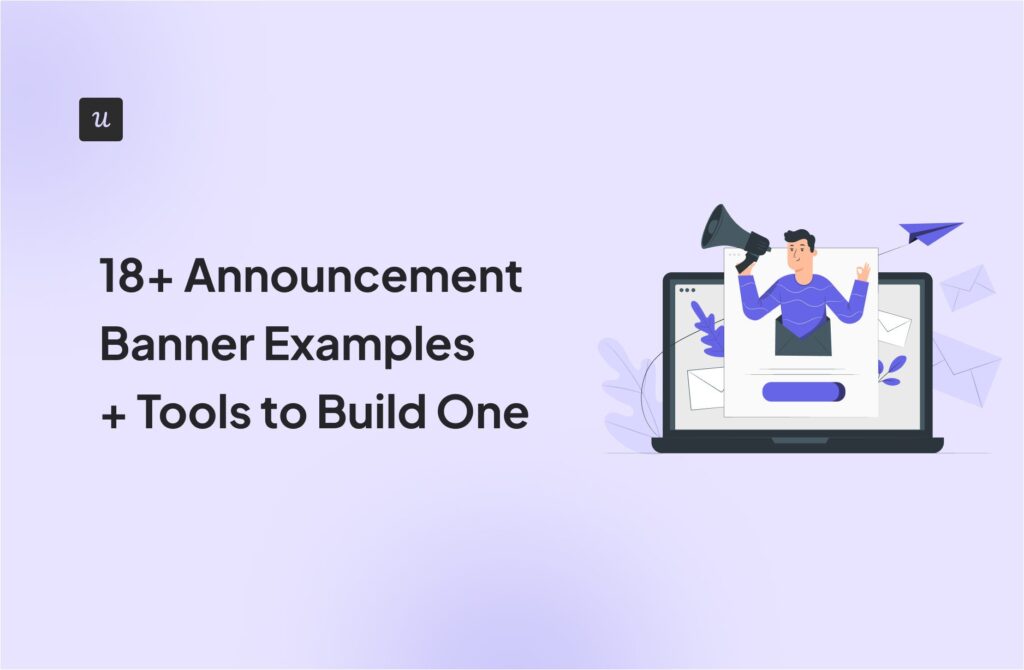![What is Competitive Analysis? [Example + Templates] cover](https://blog-static.userpilot.com/blog/wp-content/uploads/2024/07/what-is-competitive-analysis-examples-templates_09cf5412565acaa520dbacc9667caef8_2000.png)
Carrying out a competitive analysis can give your product an edge that may disrupt your industry and impact your bottom line.
This article will help you conduct your own by providing you with a competitive analysis example and some templates.
Try Userpilot Now
See Why 1,000+ Teams Choose Userpilot

What is competitive analysis?
Competitive analysis is the process of studying your rivals by looking at their strengths and weaknesses. This helps you understand what they do well and where they fall short. Doing this can improve your business strategies and help you stay ahead.
Are your competitive analyses giving you a real edge?
Comparing features isn’t enough to win the market. Take this 4-step assessment to see if your strategy is digging deep enough to improve customer engagement.
Elements of a competitive analysis report
To create a thorough competitor analysis report, you need to include several key elements. These elements help you understand your competitors and how to gain an edge over them. Here’s a look at the main components of a competitive analysis report.
- Executive summary: A brief overview of the main points in the report.
- Company overview: Basic information about the company, such as history, mission, and key stats.
- Product or service analysis: Details on the competitor’s products or services, including their pricing strategy.
- Marketing and sales analysis: Insight into competitor’s marketing tactics and sales methods.
- SWOT analysis: Evaluation of strengths, weaknesses, opportunities, and threats.
- Conclusions and recommendations: Final thoughts and suggestions based on the analysis.
How to conduct competitor analysis?
Conducting a competitive analysis involves several steps to gather and evaluate information about your own company and rivals. Here’s a simple guide to help you through the process.
1. Identify both direct and indirect competitors via market research
When conducting competitor analysis, identify direct and indirect competitors via market research.
Direct competitors like Salesforce and HubSpot offer similar products or services to the same target market.
Indirect competitors provide different solutions but address similar customer needs, such as Zoom and Slack in the communication space.
Understanding this distinction through effective product market research helps you better identify competitors and position your product.
2. Leverage user research tools to gather information
To gather detailed information about your direct competitors, leverage user research tools.
You can use surveys, interviews, or focus groups with customers. For example, in-app surveys created using Userpilot can help you gather information from customers who have switched from a competitor and why they did so.
Additionally, tools like SimilarWeb, SEMrush, and Ahrefs are great for website traffic and SEO analysis. On the other hand, Crayon can help you track changes in your competitors’ marketing strategy.

3. Analyze information to understand competitive advantage
To understand your competitive advantage, analyze the information you gather using various templates.
A feature comparison matrix allows you to compare the key features of your product with those of your competitors. A pricing comparison chart helps you see how your pricing stacks up against theirs.
Utilizing these insights from effective analyses can highlight your strengths and areas for improvement.
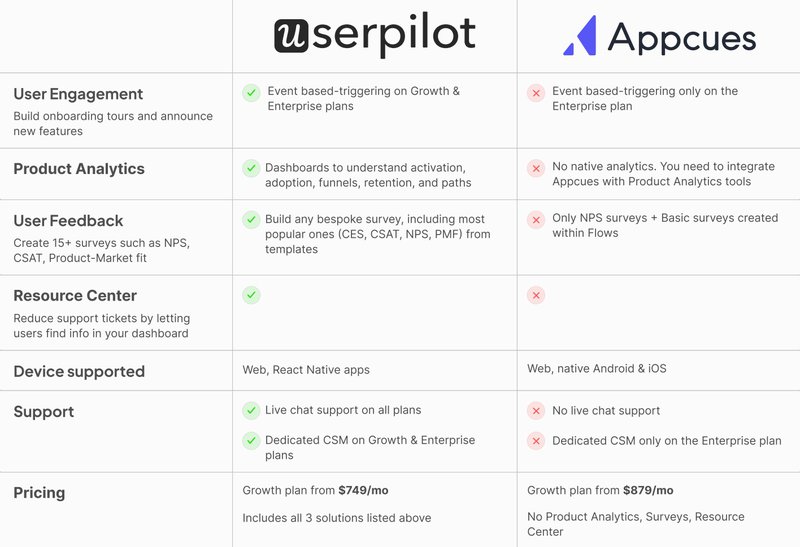
4. Use SWOT analysis to make recommendations
Using SWOT analysis is a powerful way to make informed recommendations. You can gain helpful insights by summarizing the strengths, weaknesses, opportunities, and threats.
This analysis highlights your company’s strengths, areas for improvement, potential growth opportunities, and external challenges. With this information, you can make strategic recommendations to enhance your company’s competitive advantage and position.
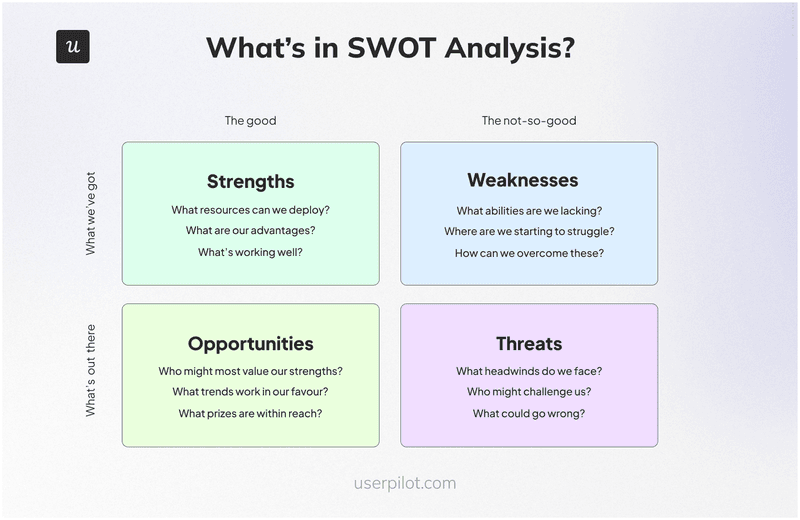
Competitive analysis examples for SaaS
Competitive analysis is crucial for SaaS companies to stay ahead in the market. Here are some competitive analysis examples that can help SaaS businesses get the job done.
Slack competitor analysis
The Slack competitor analysis compares Slack with Microsoft Teams, Zoom, and Google Meet, focusing on target audiences, pricing, key features, marketing/sales strategy, strengths, weaknesses, opportunities, and threats.
Slack serves teams of all sizes with collaboration tools and tiered pricing. Microsoft Teams targets enterprises by offering video conferencing. Zoom focuses on robust video meetings for businesses, while Google Meet integrates with Google Workspace.
Marketing strategies differ:
- Slack relies on product-led growth.
- Microsoft Teams leverages Microsoft’s brand.
- Zoom uses viral growth.
- Google Meet emphasizes Google’s ease of use.
Each competitor has strengths and weaknesses. Slack is user-friendly but costly. Microsoft Teams integrates well with Microsoft 365 but may feel bloated. Zoom is easy to use but lacks collaboration features. Google Meet integrates with Google Workspace but offers fewer features.

Monday competitor analysis
The Monday analysis compares Monday with Asana, ClickUp, and Wrike in terms of market position, target audience, pricing, features, marketing/sales strategy, strengths, weaknesses, opportunities, and threats.
Monday targets various industries, offering customizable dashboards and visual project boards with tiered pricing. Asana focuses on collaboration and project management with timeline views, while ClickUp emphasizes flexibility with various views and custom fields. Wrike caters to larger enterprises with Gantt charts and resource management tools.
Marketing strategies vary:
- Monday uses content marketing and webinars.
- Asana focuses on inbound marketing and webinars.
- ClickUp relies on word-of-mouth and social media.
- Wrike targets enterprises with content marketing.
The strengths and weaknesses of each differ. Monday is user-friendly but pricey, Asana offers strong features but is complex to set up, ClickUp is affordable but has a steeper learning curve, and Wrike has strong project management features but lacks visual appeal.
Opportunities include:
- Expanding integrations and improving user onboarding for Monday.
- Simplifying user experience for Asana.
- Refining UI/UX for ClickUp.
- Streamlining onboarding for Wrike.
Threats come from competitors’ strengths: ClickUp’s affordability, Asana’s features, and Monday and Asana’s traction with enterprise customers.
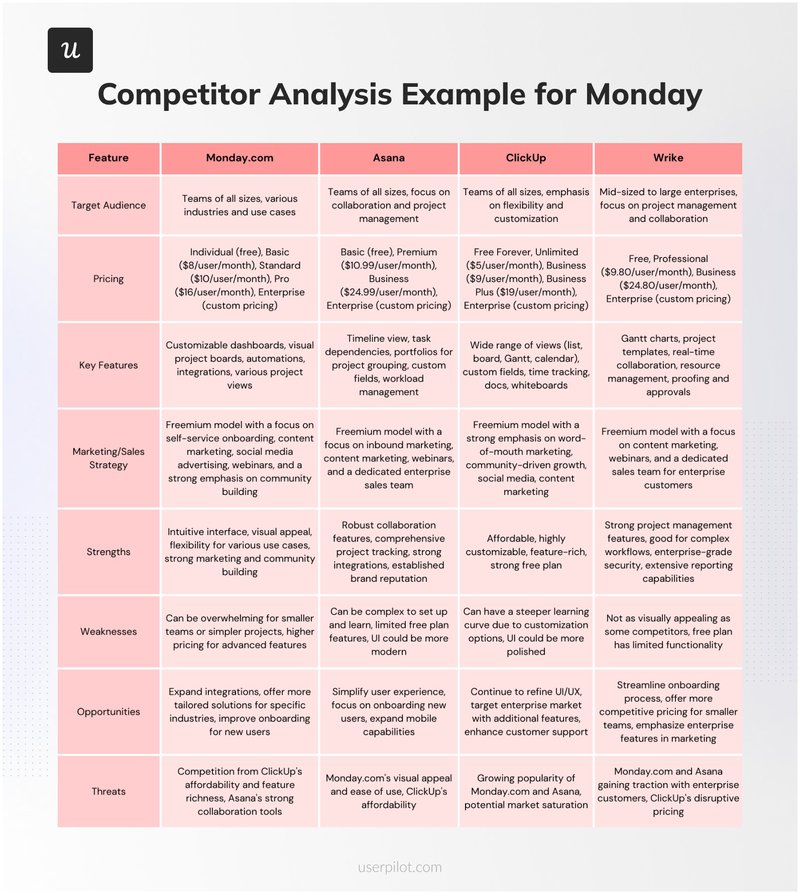
Salesforce competitor analysis
The Salesforce analysis compares Salesforce with HubSpot, Zoho CRM, and Microsoft Dynamics 365 across target audience, pricing, features, marketing strategies, strengths, weaknesses, opportunities, and threats.
Salesforce targets large enterprises with products and AI capabilities, pricing from $25 to $300 per user/month. HubSpot serves small to medium businesses, focusing on inbound marketing with free-to-enterprise-level pricing.
Zoho CRM is affordable for small to medium businesses, with plans from free to $52 per user/month. Microsoft Dynamics 365 targets mid to large enterprises, starting at $50 per user/month.
Salesforce uses an enterprise sales team, account-based marketing, thought leadership content, and partnerships. HubSpot focuses on inbound marketing and community building. Zoho CRM uses a freemium model and diverse strategies. Microsoft Dynamics 365 leverages Microsoft’s brand and partner networks.
Salesforce is a market leader but expensive and complex. HubSpot is comprehensive but limited to large enterprises. Zoho CRM is affordable and user-friendly but lacks advanced features. Microsoft Dynamics 365 integrates well with Microsoft products but is costly and complex for smaller businesses.
Opportunities include:
- More affordable pricing for Salesforce.
- Expanding enterprise offerings for HubSpot.
- Enhancing features for Zoho CRM.
- Simplifying user experience for Microsoft Dynamics 365.
Threats involve increased competition for Salesforce, market saturation for HubSpot, competition for Zoho CRM, and user-friendly solutions for Microsoft Dynamics 365.
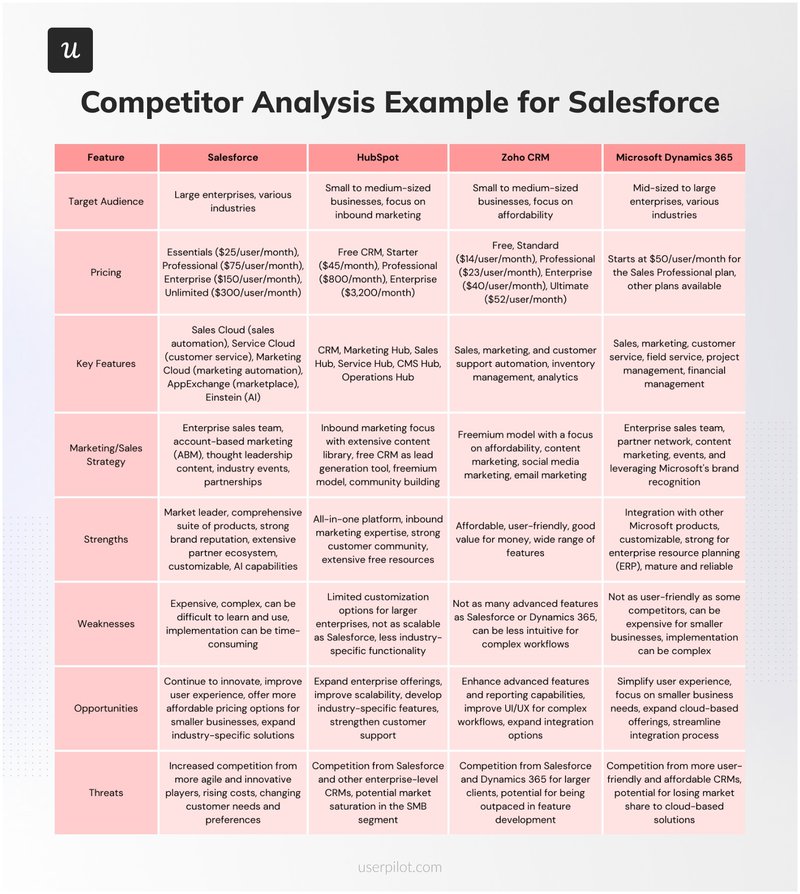
Competitive analysis templates for SaaS
Using competitive analysis templates can streamline your research and help you gather insights more efficiently. Here are some essential templates for SaaS companies to use in their competitive analysis.
Whiteboard template in Aha.io
The whiteboard template from Aha.io includes the mission, pricing, top features, strengths, weaknesses, and differentiators.
This template is useful for teams looking to map their competitive landscape visually in an organized, easy-to-understand format. It helps teams compare various aspects of their competitors side-by-side, making it easier to identify areas for improvement and opportunities.
This template is particularly helpful for product managers and marketing teams that need to present competitive analysis clearly and engagingly.
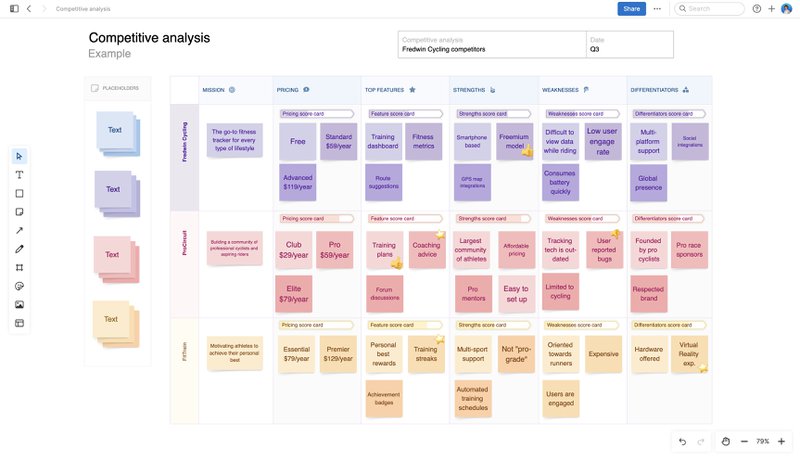
Competitive analysis template in Miro
The competitive analysis template in Miro includes elements such as competitor data, capabilities analysis, and competitor capability summary.
It categorizes capabilities into unique, best, same, and poor. This template helps teams to analyze competitors visually and compare their strengths and weaknesses.
It is especially useful for collaborative teams that want to brainstorm and discuss their findings in real-time. Product managers and marketing teams can use this template to align their strategies and identify key differentiators.
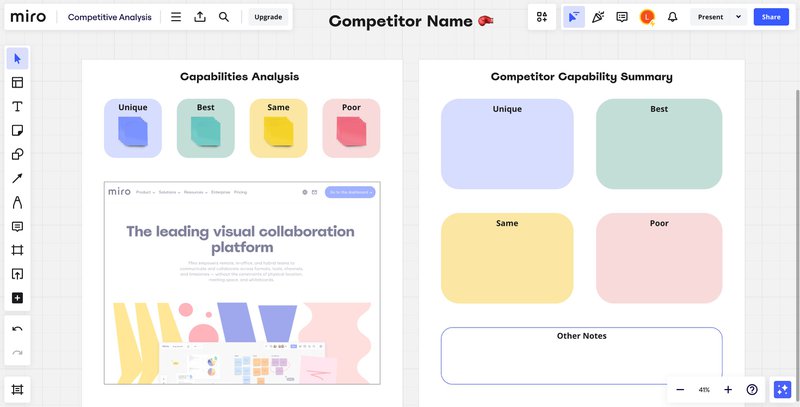
Competitor analysis template in FigJam
The analysis template in FigJam includes unique value propositions, company advantages, competitors’ weaknesses and disadvantages, similarities, differences, key learnings, and opportunities.
This template helps teams systematically compare competitors across various dimensions. It is ideal for collaborative brainstorming sessions where teams can visually map their competitive market landscape.
Product managers, marketing teams, and strategic planners can use this template to identify strengths, weaknesses, and potential areas for growth. The template’s visual nature makes it easy to spot trends and gaps in the market.
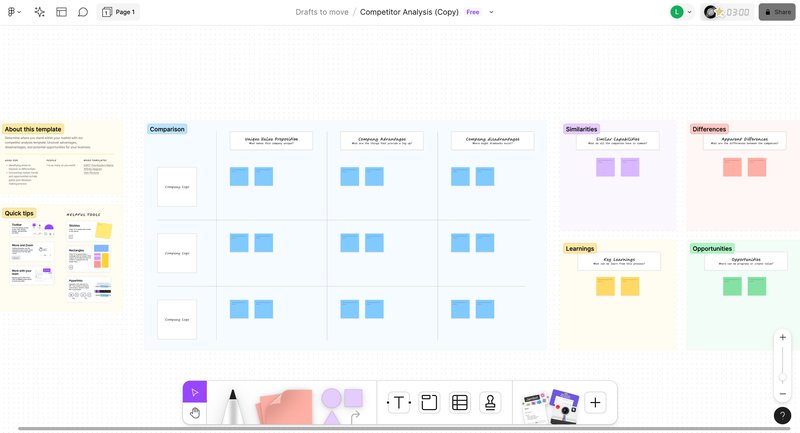
Competitor analysis template in Asana
The analysis template in Asana includes sections for an overview of the competitor analysis, pricing and packaging, and products and services.
It allows teams to compare competitors by name, size, revenue, pricing models, and key product features. This template is particularly helpful for teams already using Asana for planning and resource allocation, as it integrates seamlessly into their workflow.
Marketing teams, product managers, and sales teams can use this template to track customer demand and evaluate the competitive landscape, enabling them to make data-driven decisions.
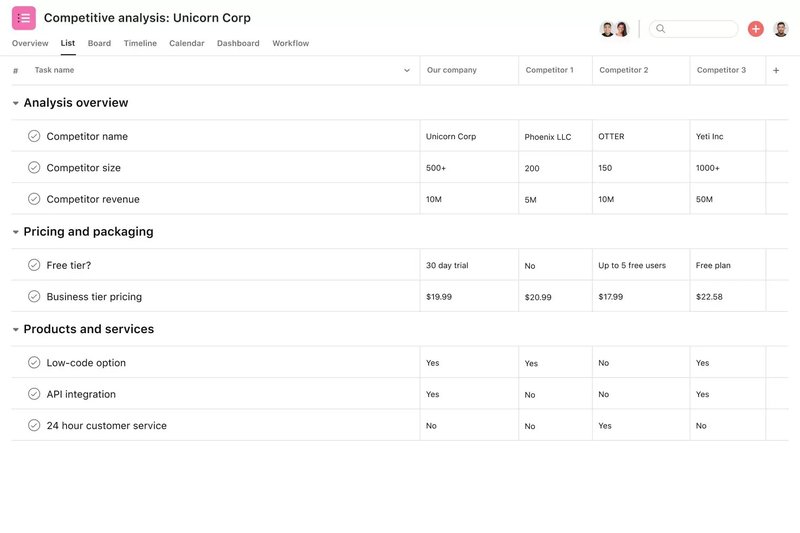
Conclusion
Now that you know exactly what your competitors are doing in your market landscape, you can create new products or introduce new market positioning that sets you apart.
One of the main things that can help you is gathering primary and secondary research data. Userpilot is the perfect tool for collecting market research data from your customers directly in your product. If you want to find out more, book a Userpilot demo now!



![10 Free Product Roadmap Templates You Need in 2026 [+Free Download] cover](https://blog-static.userpilot.com/blog/wp-content/uploads/2026/01/10-product-roadmap-templates-you-need-in-2026-free-download_d8269f0b0b9749f6ad7b519ab7ac1833_2000-1024x670.png)

